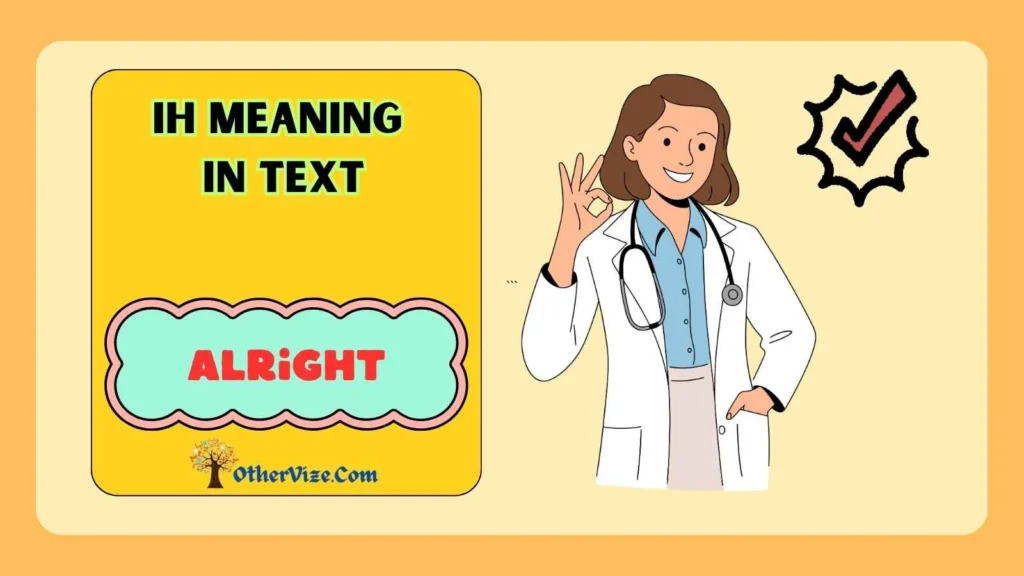The phrase ih meaning in text often confuses people because it’s not as widely recognized as other internet abbreviations. When someone suddenly receives “ih” in a chat, DM, or social media comment, it can feel vague, unclear, or even emotionally charged.
This uncertainty is why many people search for its meaning.
In modern texting culture, short expressions evolve quickly, and “ih” is one of those informal responses that reflect tone more than literal meaning.
It may sound simple, but its interpretation depends heavily on mood, context, and the relationship between the people chatting.
This article provides a complete breakdown of what “ih” stands for, how it is used, its history, clarifications, and even the best ways to respond.
By understanding this term deeply, you can navigate conversations more confidently without misinterpreting someone’s intent.
Definition & Meaning
The ih meaning in text usually represents a short, neutral, or indifferent reaction. It’s similar to saying “okay,” “hmm,” or “alright” in a tone that feels emotionless or mildly dismissive.
People use “ih” when they want to respond without showing strong feelings—positive or negative. It may reflect:
- Disinterest
- Mild annoyance
- Uncertainty
- A soft acknowledgment
- An emotionally neutral “okay”
It’s not typically used for excitement or agreement. Instead, it signals a low-energy or unbothered reply.
Background & History
While many text abbreviations come from early SMS culture, “ih” developed more organically. It isn’t an acronym but rather an expressive sound typed out to reflect tone.
As messaging moved toward expressing emotions quickly, people began using small letter combinations like “uh,” “eh,” or “hm.” “Ih” became part of this trend—an informal expression typed to show a subtle emotional state without crafting full sentences.
Its rise is linked to platforms like Snapchat, TikTok, and Instagram, where short replies are common and tone-based texting expressions gain popularity.
Usage in Various Contexts
The ih meaning in text can shift depending on the situation:
1. Casual Conversations
Used as a neutral or indifferent response:
- “Ih, it’s okay.”
- “Ih, whatever.”
2. Annoyance or Disinterest
When someone doesn’t want to continue the topic:
- “Ih, it doesn’t matter.”
3. Light Dismissal
Not rude, but not enthusiastic either:
- “Ih, it’s fine.”
4. Emotional Distance
Used when someone is upset or not in the mood to chat:
- “Ih, I’m tired.”
5. Humor or Sarcasm
Some use it jokingly to downplay something:
- “Won a game?”
“Ih.”
Tone decides everything, so context is essential.
Common Misconceptions & Clarifications
People often misunderstand “ih” in texting:
- Not an acronym: It doesn’t “stand for” anything; it’s a reaction word.
- Not always rude: Some assume it’s disrespectful, but often it’s just neutral.
- Not a refusal: It doesn’t necessarily mean “no,” though it may show hesitation.
- Not an expression of anger: It’s usually calm, not confrontational.
Clearing up these misconceptions helps avoid unnecessary conflict.
Similar Terms & Alternatives
Other expressions that convey a similar tone:
- “eh”
- “idk”
- “hm”
- “ok ig” (okay, I guess)
- “uhh”
- “k”
These alternatives vary in emotion but all express low energy or minimal enthusiasm.
How to Respond to This Term
Your reply depends on the conversation’s flow:
- If they seem uninterested:
“Do you want to talk later?” - If you need clarity:
“What do you mean by ih?” - If they sound upset:
“Is everything okay?” - If it’s casual:
“Alright, cool.”
The goal is understanding the tone, not just the letters.
Regional or Cultural Differences
“Ih” doesn’t have a strong cultural origin, but:
- North America & Europe: Used casually, often among teens.
- Asia & Middle East: Less common; people prefer “hmm” or “idk.”
- Latin America: Sometimes replaced with “ehh” or “pss.”
Its usage depends more on internet culture than geography.
Comparison with Similar Terms
| Term | Tone | Meaning | Common Use |
|---|---|---|---|
| ih | Neutral/indifferent | Acknowledgment with low emotion | Casual chats |
| eh | Slight uncertainty | Not fully convinced | Mixed feelings |
| hm | Thinking or analyzing | Considering something | Decision-making |
| k | Abrupt | Short “okay” | Ending conversations |
| idk | Uncertain | “I don’t know” | When unsure |
“Ih” stays uniquely subtle compared to these.
Usage in Online Communities & Dating Apps
Online communities use “ih” for soft reactions:
- Reacting to memes
- Downplaying achievements
- Ending debates
- Showing low excitement
On dating apps, it can indicate:
- Shyness
- Emotional distance
- Losing interest
- Discomfort with a topic
Reading the vibe is essential.
Hidden or Offensive Meanings
“Ih” is not offensive by definition.
However, it can feel rude if:
- The conversation is important
- Someone expects a warm response
- It follows a heartfelt message
Its meaning shifts with tone, not wording.
Suitability for Professional Communication
“Ih” is not suitable for professional environments.
In work messages, it can come across unprofessional or dismissive. Instead, use:
- “I’m not sure.”
- “I need more details.”
- “It’s okay for now.”
Clear phrasing avoids misunderstandings.
FAQs:
What does ih mean in texting?
It’s a neutral, low-energy reaction meaning “okay,” “alright,” or mild indifference.
Is ih rude?
Not always. Tone and context determine whether it feels rude or neutral.
Is ih an acronym?
No, it’s an expressive sound used to show subtle emotion.
Do teens use ih more?
Yes, it’s most common among younger social media users.
Can ih mean someone is upset?
Possibly—especially if used in short, dry replies.
How do I respond to ih?
Ask for clarity or continue normally depending on the conversation.
Conclusion:
Understanding the ih meaning in text helps you interpret tone-sensitive digital conversations more accurately. Since it reflects emotional openness or disinterest rather than a literal meaning, recognizing context prevents miscommunication.
Whether someone uses “ih” casually, jokingly, or to express moodiness, being aware of its nuances allows you to reply appropriately and maintain smoother, clearer interactions across different online spaces.
